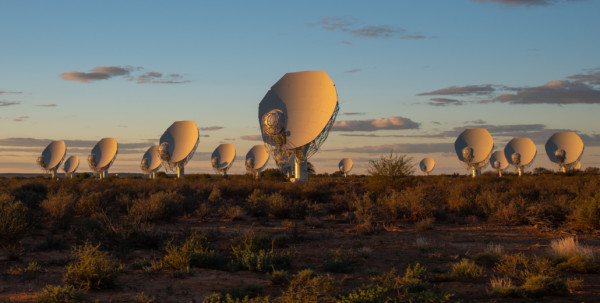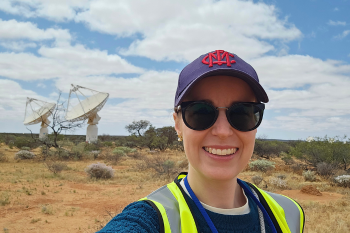© Pint of Science, 2025. All rights reserved.
In Australia and around the world, astronomers are developing a deeper understanding of the cosmos and all it contains. Aiding them is an array of animal acronyms.
Advancing astronomy
For millennia, researchers have been carrying out studies of the sky and its cosmic components. However, not all astronomic phenomena are immediately visible to the human eye. Aptly named radio stars and the remnants of supernova explosions, for example, emit radio waves rather than visible light, meaning researchers must use different techniques to ‘see’ and study them.
Radio waves exist at the opposite end of the electromagnetic spectrum to x-rays. Specialised radio telescopes can be tuned to pick up these low-frequency waves. Unlike optical telescopes, they can collect data at all hours of the day and night, in rain, hail and shine. (Lightning is almost the only weather that can interrupt radio telescope observations.)
Radio waves hailing from space were first detected in the 1930s, but it wasn’t until after World War II that significant advances were made. Equipment once used to detect incoming aircraft was repurposed and tuned in to radio waves from space.
The first radio telescope to generate daily two-dimensional maps of the sun, known as the Chris Cross, was established in Sydney in 1957. The Parkes radio telescope, also in New South Wales, began operation in 1961 and was in a prime position to receive video footage of the first moon walk that same decade. Today the Parkes telescope is more than 10,000 times as sensitive as when it was established.
Naming by nature

MeerKAT radio telescope. Image courtesy South African Radio Astronomy Observatory (SARAO).
A radio telescope overseas introduces us to our first animal acronym: MeerKAT, situated in the Karoo region of South Africa. Technically, MeerKAT is an interferometer, which means it collates data from multiple antennas (each one shaped like a satellite dish) to simulate a much larger telescope. (For the linguists and trivia enthusiasts out there, insects have antennae, but radio telescopes have antennas!)
MeerKAT consists of 64 antennas. Each one measures 13.5 metres in diameter and weighs about as much as seven African elephants! (Of course, real meerkats are residents of the Karoo region too.)
Australia also hosts an interferometer, known as ASKAP. Although smaller than its South African counterpart (ASKAP has 36 antennas), ASKAP has made it possible to more than double the number of known radio stars.
One project using ASKAP goes by the acronym POSSUM! In this case, researchers are conducting a comprehensive survey of magnetic fields in the Milky Way based on a phenomenon known as redshift, which is when light appears red as its source moves further away. Survey projects going by the acronyms DINGO, EMU and WALLABY will each make their own contributions to cosmological knowledge.
With the help of technology like ASKAP, researchers can visualise explosive, highly energetic and very short-lived phenomena in space—things like supernova explosions and stars being torn apart by black holes (officially known as tidal disruption events). One of those researchers is Dr Laura Driessen.
Introducing Astro Laura

Astro Laura and the ASKAP radio telescope. Photo courtesy Dr Laura Driessen.
Dr Laura Driessen, also known as Astro Laura, is a radio astronomer with a longstanding fascination for all things space. As a four-year-old, Laura was entranced by an inflatable planetarium set up at Croydon library in Melbourne. Thirteen years later she attended the International Science School in Sydney and had the lightbulb moment that ‘astronomer’ could be a career.
Today Laura well and truly proves that point. After completing an undergraduate science degree at Monash University, she went on to study at the University of Amsterdam and was awarded a graduation prize for best astronomy master’s thesis in the Netherlands.
Laura earnt her PhD for research into radio transients with the aforementioned MeerKAT radio telescope and is now working as a postdoctoral researcher at the Sydney Institute for Astrophysics—and generously sharing her knowledge and experience with Pint of Science!
Engaging the astronomer in you
Opportunities abound for engaging the budding astronomer in you.
You can hear from astronomers, astrophysicists and more during our annual festival, being held from 19 to 21 May 2025.
Dr Laura Driessen will present ‘Finding radio stars in a haystack of black holes’ at The Commercial Hotel, Sydney, on Tuesday 20 May 2025. Find out more about this year's events and book tickets on our festival page.
Until then, you can read more about the links between animals and astronomy in an article Laura wrote for The Conversation and, of course, take a look up at the stars where you are tonight!
References
Andersson, A., Lintott, C., Fender, R., Bright, J., Carotenuto, F., Driessen, L., Espinasse, M., Gasealahwe, K., Heywood, I., Van Der Horst, A. J., Motta, S., Rhodes, L., Tremou, E., Williams, D. R. A., Woudt, P., Zhang, X., Bloemen, S., Groot, P., Vreeswijk, P., . . . Whittle, I. (2023). Bursts from Space: MeerKAT – the first citizen science project dedicated to commensal radio transients. Monthly Notices of the Royal Astronomical Society, 523(2), 2219–2235. https://doi.org/10.1093/mnras/stad1298
ASKAP Survey Science Projects - Australia Telescope National Facility. (2024, December 2). Australia Telescope National Facility. https://www.atnf.csiro.au/projects/science/wide-area-surveys/askap-survey-science-projects/
Camilo, F. (2018). African star joins the radio astronomy firmament. Nature Astronomy, [online] 2(7), pp. 594–594. doi: https://doi.org/10.1038/s41550-018-0516-y.
CSIRO. (n.d.). Murriyang, our Parkes radio telescope. https://www.csiro.au/en/about/facilities-collections/ATNF/Parkes-radio-telescope-Murriyang
CSIRO. (n.d.-b). What is radio astronomy? https://www.csiro.au/en/research/technology-space/astronomy-space/what-is-radio-astronomy




